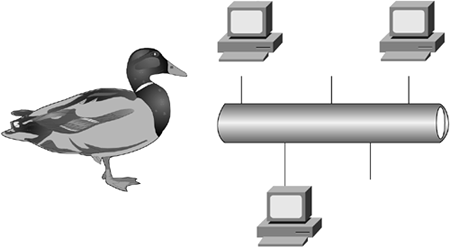Chapter 8. Virtual LANs (VLANs)
What You Will Learn
On completing this chapter, you will be able to:
Describe a virtual LAN
List three VLAN types
Describe communications within and between VLANs
List three VLAN modes
List the Layer 3 switches in VLANs
Explain the benefits of using VLANs
This chapter takes the concept of a physical local-area network (LAN), throws it against the wall, picks up the pieces, and reassembles them. The LANs thus far discussed have all been based on physical topology and single broadcast domains with no segmentation?where there is cabling, there is a broadcast domain.
But that is all about to change. If it looks like a duck, walks like a duck, and quacks like a duck, it's a duck, right? Looks like it in Figure 8-1.
Figure 8-1. Ducks and LANs

If it looks like a LAN and talks like a LAN, it's a LAN, right? But what if it doesn't look like a LAN, but in fact has computers spread out all over; can it still talk like a LAN? In fact, it can by using a virtual LAN, or VLAN.
note
A broadcast domain is an area within a network topology in which information transmitted in the domain is received by all devices within the same domain. Ethernet LANs are broadcast domains because any network device attached to the LAN can transmit frames to any other network device in the shared transmission medium. |






